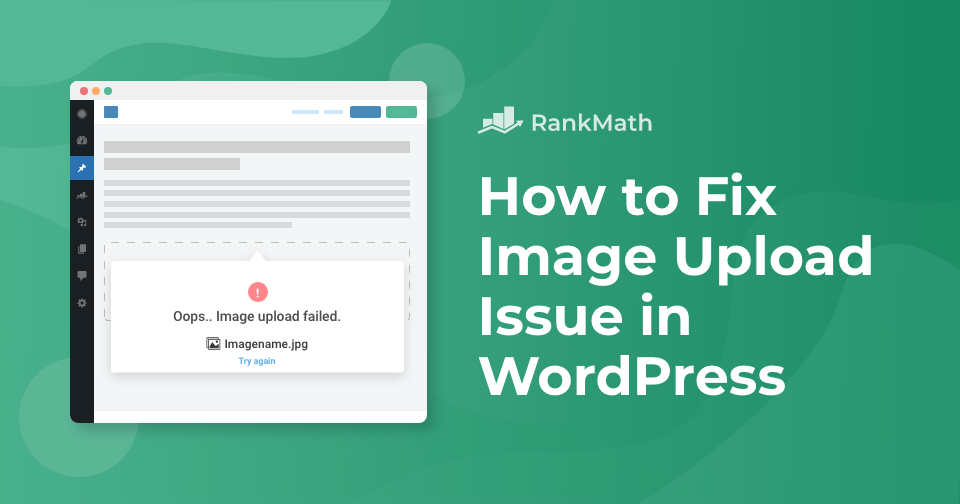Images are an essential component of any website as they further help enhance your site. Nowadays, most of us can’t imagine writing a blog article without using images.
Certainly, the text on your blog will always play a significant role in SEO. However, using images in your post will help it stand out and drive more visitors to your site.
When you’re regularly uploading images to your WordPress website, it’s natural to encounter an error message now and then. But you need not worry. Fortunately, even the most obscure image upload issues in WordPress can be easily diagnosed.
In this article, we’ll figure out the image-related issues and look at some easy hacks to avoid them in the future. Then, the next time, when the WordPress Media Library refuses to cooperate with your creative vision, you should have no trouble adding gorgeous, eye-catching visuals to your website.
So, without further ado, let’s get started!
Table Of Contents
- Fix Image Upload Issues – Video Tutorial
- Common WordPress Image Upload Errors and Solutions to Fix Them
- Change File Permissions
- Rename the Image
- Resize the Image
- Clear the Cache
- Deactivate the Plugins
- Check the Theme
- Increase the PHP Memory Limit
- Try the Browser Uploader
- Switch the Browsers
- Check the PHP Version
- Conclusion
1 Fix Image Upload Issues – Video Tutorial
Don’t want to read? You can learn how to fix common upload issues in WordPress with our video tutorial.

2 Common WordPress Image Upload Errors and Solutions to Fix Them
Beautiful, attention-seeking images are an integral part of almost any website. Product images are especially significant for generating sales in an e-commerce site since they allow customers to see what they’re buying.
Nothing is worse than spending 10 minutes trying to find that perfect image for your blog post or your e-commerce site, you go to upload it, and bam, you suddenly greet a very vague error such as An error occurred in the upload. Please try again later.

Failure to upload images is one of the most common image issues in WordPress. These image upload issues can be triggered due to a wide range of factors.
Let us now look at the common image upload issues and how you can quickly resolve them and get back to uploading the media on your site.
2.1 Change File Permissions
One of the most common problem is incorrect file permissions.
WordPress cannot read or upload files on the hosting server due to incorrect file permissions. When uploading an image file, you may receive the following error: Unable to create directory wp-content/uploads/2022/14. Is its parent directory writable by the server?
Another sign of this issue is that your images may not appear in the media library. You can then change the file permissions and solve the image upload issue.
To change the file permissions, connect your website through FTP. Navigate to the /wp-content/ folder. Inside, you’ll find the uploads folder, where all your media uploads are stored, including images. Right-click on the uploads folder and select File permissions, as shown below.
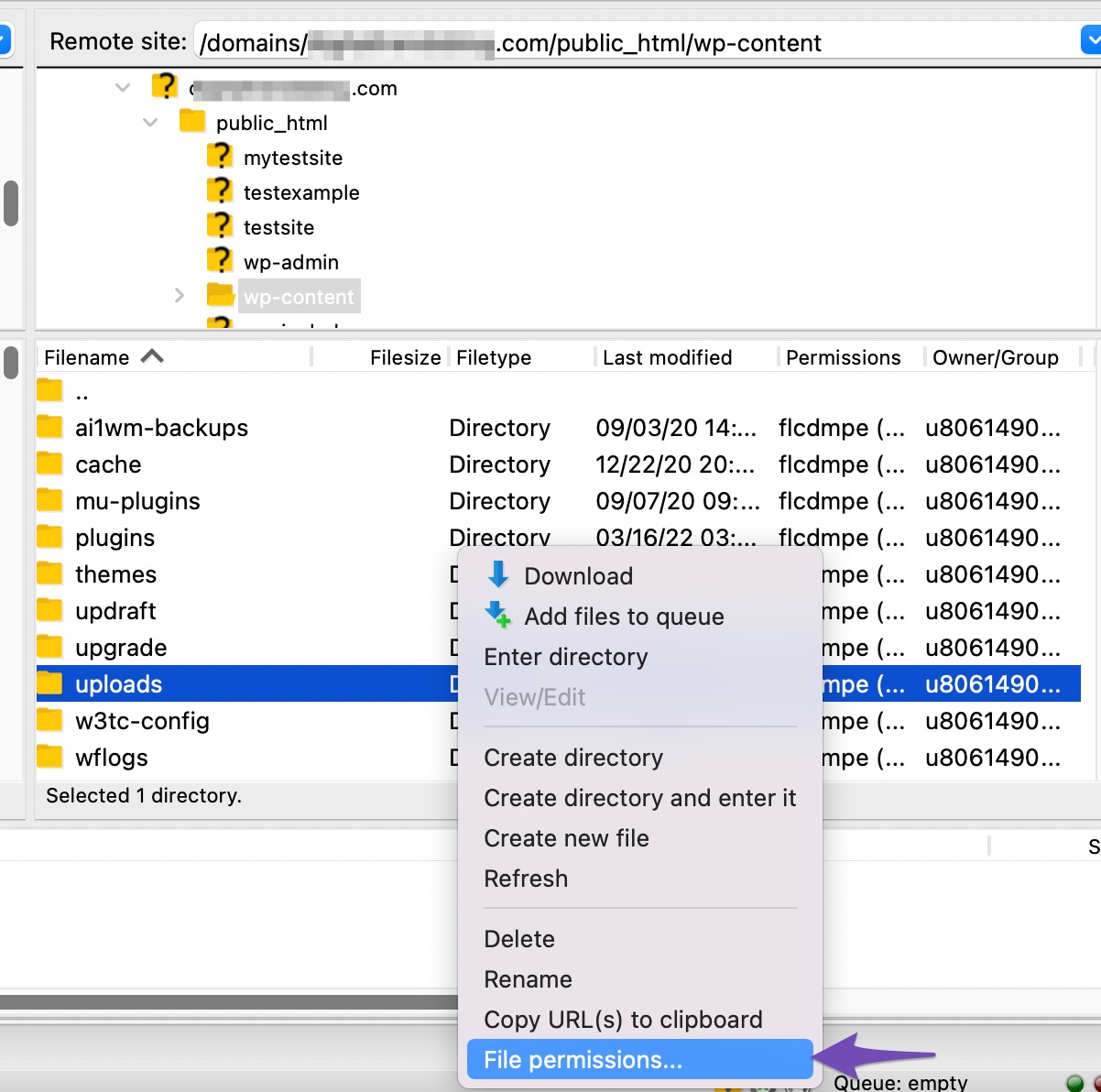
Type 744 into the number value box and check the box next to the option Recurse into subdirectories. Now select the radio option that says ‘Apply to directories only.’
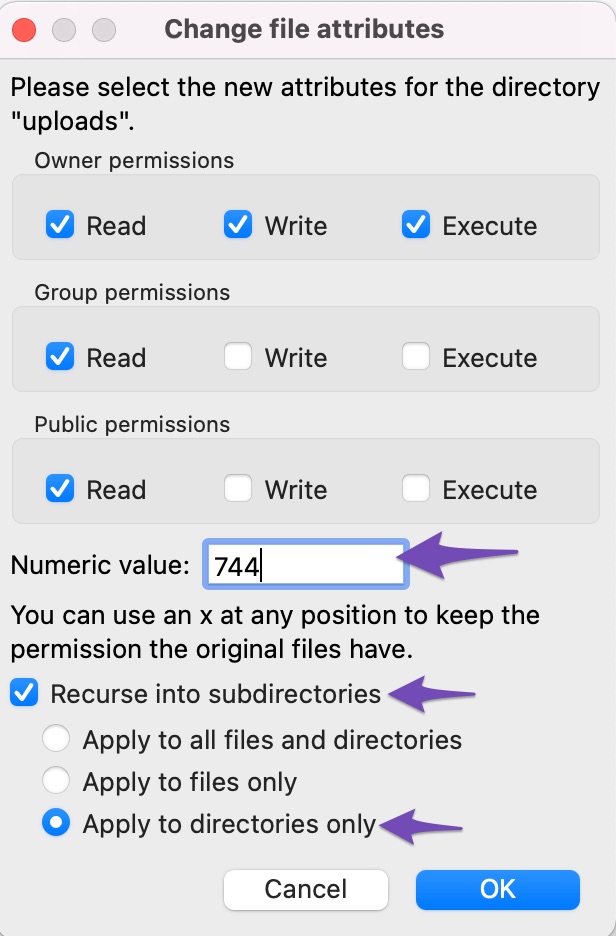
To save your changes, click the OK button. Your FTP client will now apply the file permissions for the directories. If this doesn’t work, set the value to 755 and try again.
Next, you’ll need to set file permissions for all the files in the uploads directory.
To do so, right-click the uploads directory and select the File permissions option from the menu. Change the numeric value to 644 in the file permissions dialogue box.
Check the box next to Recurse into subdirectories. Lastly, you need to select the radio option that says Apply to files only. To save your changes, click the OK button.
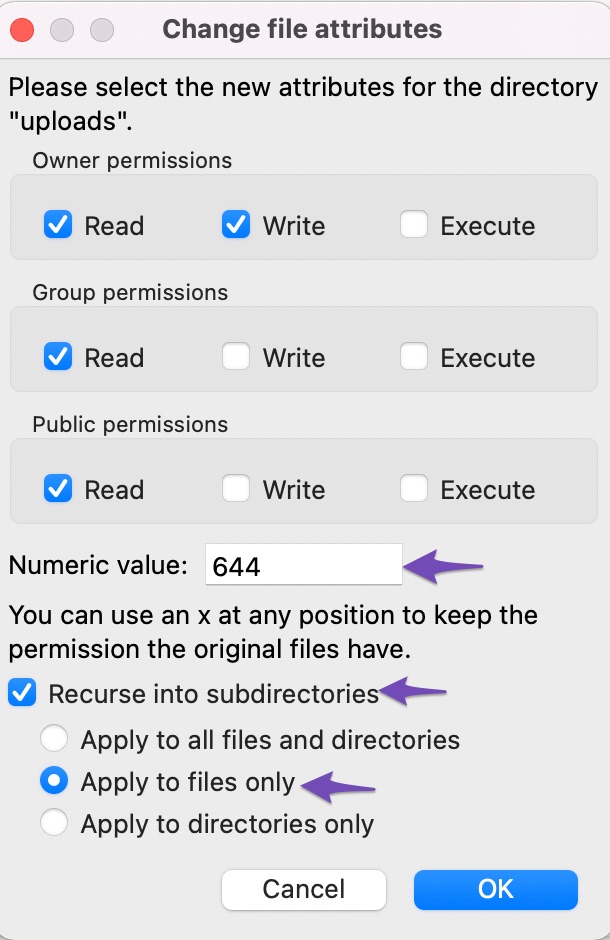
All files in the uploads folder will now have their permissions changed by the FTP client. You can now return to your WordPress admin area and attempt uploading the images once more. This should solve the image upload issue on your site.
2.2 Rename the Image
If you’re only experiencing trouble with a single image, start by looking at the file’s name. The WordPress uploader may have problems uploading your image if you use special characters ($, *, &, #) or accent letters (ñ, á, é). Rename the image with the correct file name and upload it again.
2.3 Resize the Image
It’s also possible that the image is too big, both in terms of dimensions and file size. You can try reducing the size by using image compression tools. But if you regularly encounter this problem, you can raise the limit by adding code to the site’s php.ini file.
upload_max_filesize = 128M
post_max_size = 128M
max_execution_time = 3002.4 Clear the Cache
If you’re using a caching plugin like WP Rocket or W3 Total Cache, clearing the cache might be all you need to fix your image upload issues. If you think that caching could cause the error, your steps will depend on your chosen caching plugin.
For example, if you’re using the WP Rocket plugin, you can clear the cache by selecting WP Rocket → Clear cache from your WordPress toolbar.
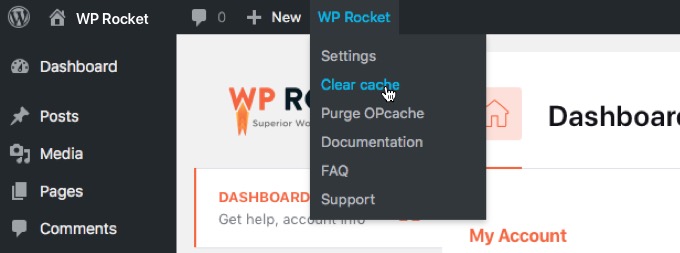
If you’re not sure how to clear the cache in your specific plugin, the plugin’s Settings menu is usually a good place to start. For further information, you can visit the developer’s official documentation.
2.5 Deactivate the Plugins
Plugins are the bread and butter of the WordPress system. If you’re using any plugins, it’s always worth trying disabling them one at a time to see if it fixes your image upload issue.
To deactivate the plugins, navigate to Plugins → Installed Plugins from your WordPress dashboard to deactivate the plugins. Select the plugins from the list and choose the Deactivate option from the drop-down menu. Then click on the Apply button as shown below.

If this does not solve the problem, get in touch with the plugin developer to see if they can help you fix the image upload issue on your site.
2.6 Check the Theme
Another option is to back up your website and switch to a default theme for a short period of time. If your image uploads properly, the issue is most likely with your current theme.
To further troubleshoot the image upload issue on your site, contact the theme developer.
2.7 Increase the PHP Memory Limit
When you try to upload an image, you can get an HTTP error from WordPress. Low server resources or unusual traffic might also cause this error. As a result, waiting a few minutes before attempting to re-upload the image is always a good idea.
If the problem persists, you may have reached the WordPress memory limit. You can increase the amount of memory by connecting your site using FTP. To fix this, increase the limit to 256MB by adding the following code snippet to your wp-config.php file.
define('WP_MEMORY_LIMIT', '256M');Try uploading the file again and your image upload issue should be resolved.
2.8 Try the Browser Uploader
If you’ve tried all of the above ways and still experiencing problems, you can use the built-in file uploader in your browser. Unlike the WordPress image uploader, the browser uploader does not support multiple file selection or drag and drop. However, it can be a beneficial workaround when you need to upload an image quickly.
Navigate to Media → Add New from your WordPress dashboard to use the image uploader. Select the browser uploader link and click on Choose File.
This brings up the file selection dialogue, where you can upload the image as usual. If this fix is successful, you should try uploading an image using WordPress standard image uploader to determine if your image upload issue has been solved.

2.9 Switch the Browsers
When using Google Chrome, users occasionally report HTTP problems. Changing browsers may assist you in determining whether or not the problem is due to your website.
If you can upload the file in another browser, you should contact your chosen platform’s support to figure out what’s causing the problem.
2.10 Check the PHP Version
Check the PHP version of your site. Anything lower than version 7 will cause problems, especially if you’re using the most recent WordPress version. WordPress officially recommends PHP 7.4 or higher, while it will also function with previous versions.
You can check the version by navigating to Tools → Site Health from your WordPress dashboard. Click on the Info tab and select the Server section, and you’ll be able to find your server details.

You can update the PHP version from your hosting dashboard and then try uploading the image. Your image upload issue should disappear once you’ve updated the PHP version.
3 Conclusion
If you create content frequently, you’ll most certainly encounter the image upload error eventually (or other HTTP error codes and status codes). Hopefully, one of the methods listed above should work for you, and you should be back on track with your media uploads.
Have any additional questions about the image upload issues you’d like us to cover in this post? Let us know by Tweeting @rankmathseo. 💬
